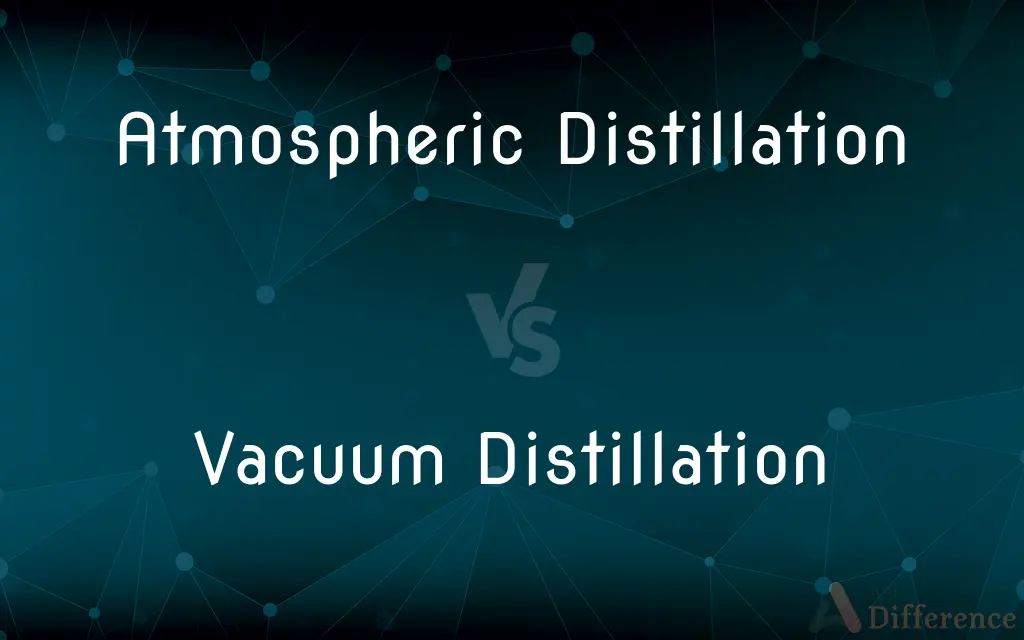Atmospheric Distillation vs. Vacuum Distillation — What's the Difference?
By Tayyaba Rehman — Published on November 2, 2023
Atmospheric Distillation operates at normal atmospheric pressure, separating compounds based on boiling points. Vacuum Distillation employs reduced pressure, allowing for the distillation of heat-sensitive compounds.

Difference Between Atmospheric Distillation and Vacuum Distillation
Table of Contents
ADVERTISEMENT
Key Differences
Atmospheric Distillation is a process that takes place at the pressure of the surrounding environment. This standard method separates liquids or components based on their respective boiling points under ambient pressure. One common application is the primary distillation of crude oil in refineries. On the other hand, Vacuum Distillation is conducted under reduced pressure conditions. The major advantage here is that by reducing the pressure, the boiling points of the compounds are also lowered. This means that substances which might decompose or react at higher temperatures can be distilled without any damage.
In Atmospheric Distillation, components that have boiling points below the atmospheric pressure are typically separated. It's more suited for compounds that don't degrade at higher temperatures. Conversely, Vacuum Distillation is particularly beneficial for purifying or isolating compounds that are thermally unstable. The reduction in pressure effectively allows for distillation at lower temperatures.
Furthermore, Atmospheric Distillation is frequently used for refining processes, especially in the petrochemical industry. Here, the crude oil undergoes initial distillation to separate into various fractions. Vacuum Distillation, meanwhile, finds its application in the pharmaceutical industry, laboratories, and situations where delicate compounds need to be separated.
Another distinction is the equipment. The setups for both methods differ, primarily because Vacuum Distillation requires a system that can maintain and control the reduced pressure, like a vacuum pump. In contrast, Atmospheric Distillation systems are generally simpler since they operate under regular pressure.
Comparison Chart
Pressure Conditions
Operates at atmospheric pressure
Operates under reduced pressure
ADVERTISEMENT
Typical Applications
Petrochemical refining
Laboratories, pharmaceuticals, and heat-sensitive compounds
Boiling Points
Distills compounds at their normal boiling points
Lowers boiling points of compounds
Equipment Complexity
Simpler, no need for vacuum systems
Requires systems to maintain and control reduced pressure
Suitable Compounds
Compounds stable at higher temperatures
Thermally unstable or heat-sensitive compounds
Compare with Definitions
Atmospheric Distillation
Predominantly used for compounds stable at higher temperatures.
Kerosene is one of the products obtained through Atmospheric Distillation of crude oil.
Vacuum Distillation
Commonly used for thermally unstable or delicate compounds.
In pharmaceutical research, Vacuum Distillation aids in obtaining pure substances without heat damage.
Atmospheric Distillation
Distillation under ambient atmospheric pressure.
Crude oil refining often uses Atmospheric Distillation for initial separation.
Vacuum Distillation
Distillation conducted under reduced pressure conditions.
Vacuum Distillation is ideal for purifying heat-sensitive organic compounds.
Atmospheric Distillation
Standard procedure for primary separation in many industries.
The petrochemical industry relies heavily on Atmospheric Distillation.
Vacuum Distillation
Finds extensive application in labs and specific industries.
Many essential oils are extracted using Vacuum Distillation to preserve their qualities.
Atmospheric Distillation
Separation method based on compounds' normal boiling points.
In Atmospheric Distillation, gasoline and diesel fractions are separated based on their different boiling points.
Vacuum Distillation
Technique lowering the boiling points of substances by reducing pressure.
By employing Vacuum Distillation, fragile compounds can be distilled without degradation.
Atmospheric Distillation
A technique requiring simple equipment setups.
Atmospheric Distillation towers in refineries are tall structures allowing for effective separation.
Vacuum Distillation
Requires specific equipment to maintain and control low pressure.
Vacuum Distillation setups are often equipped with advanced vacuum pumps and control systems.
Common Curiosities
Why does Vacuum Distillation lower boiling points?
Reducing the pressure decreases the temperature required for a compound to boil.
What is the primary condition for Atmospheric Distillation?
It operates under the pressure of the surrounding environment or atmospheric pressure.
Why use Vacuum Distillation?
It's ideal for distilling heat-sensitive or thermally unstable compounds.
What's a common application for Vacuum Distillation?
It's often used in the pharmaceutical industry and in labs.
Are there compounds that can only be separated using Vacuum Distillation?
Yes, especially those that might degrade at higher temperatures.
Can Atmospheric Distillation handle thermally sensitive compounds?
Generally, it's better suited for compounds stable at higher temperatures.
How do the equipment setups differ between the two methods?
Vacuum Distillation requires systems to maintain reduced pressure, while Atmospheric Distillation setups are simpler.
Can Vacuum Distillation work at atmospheric pressure?
No, it operates under reduced pressure conditions.
How does Atmospheric Distillation separate compounds?
Based on their respective boiling points under ambient pressure.
Can essential oils be extracted using Vacuum Distillation?
Yes, many essential oils are extracted this way to preserve their properties.
Is Atmospheric Distillation used in the petrochemical industry?
Yes, especially for the primary distillation of crude oil.
Which method is more complex in terms of equipment?
Vacuum Distillation requires more specialized equipment.
Is the petrochemical industry the only user of Atmospheric Distillation?
No, but it's one of the primary industries that use this method extensively.
Why might a compound distilled under Vacuum Distillation not work in Atmospheric Distillation?
The compound might be heat-sensitive and degrade at the higher temperatures of Atmospheric Distillation.
Does Atmospheric Distillation need a vacuum pump?
No, it operates at normal atmospheric pressure.
Share Your Discovery

Previous Comparison
Wellbeing vs. Well-being
Next Comparison
Single Electrode Potential vs. Standard Electrode PotentialAuthor Spotlight
Written by
Tayyaba RehmanTayyaba Rehman is a distinguished writer, currently serving as a primary contributor to askdifference.com. As a researcher in semantics and etymology, Tayyaba's passion for the complexity of languages and their distinctions has found a perfect home on the platform. Tayyaba delves into the intricacies of language, distinguishing between commonly confused words and phrases, thereby providing clarity for readers worldwide.
















































